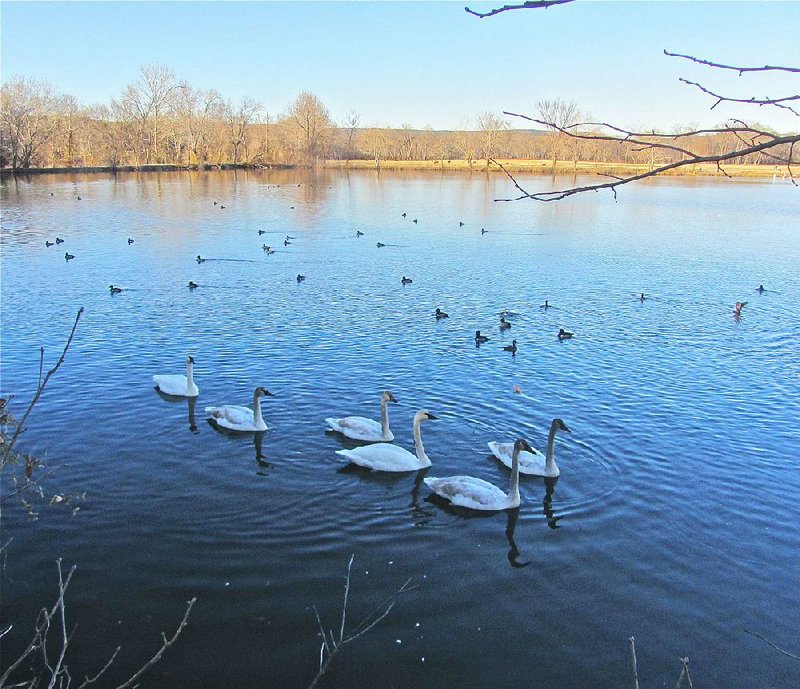MAGNESS LAKE -- One of Arkansas' rarest and loveliest wildlife sightings can be savored this time of year at a small lake on private farmland 65 miles north of Little Rock. Magness Lake affords close-up winter viewing of trumpeter swans, North America's largest waterfowl species.
Nearly extinct in the Lower 48 states in the 1930s, this majestic white bird with a wingspan up to 8 feet arrived in the winter of 1992 as a surprise visitor to the 30-acre lake.
Trumpeters are much more commonly found in the Upper Midwest or Mountain states. This oxbow lake six miles east of Heber Springs is about as far south as they've been known to migrate. It is thought that a severe storm farther north may have driven the first three swan visitors south 24 years ago.
Thanks to the generosity of the lake's owners, Patti Eason and her late husband, Larry, along with their son Brian, visitors can access the site free of charge. Parking is available at a bend on Hays Road next to the lake, where only a waterfront wire fence separates curious humans from the swans.
Around 4 p.m. on New Year's Day, almost a dozen vehicles were parked on the gravel roadside, where two signs tell the story of the big birds and set down a few rules for watchers.
For one thing, "All pets must remain in vehicles. Your pets being on property may lessen the swans' fear of predators such as coyotes and bobcats that have killed some swans in the past." Climbing on the fence is forbidden, and the swans should be fed only clean shelled corn. They should not be touched, period.
No telephoto lens was needed to photograph the 30 or so swans, most of them in five or six family groups floating serenely within easy corn-tossing distance of the fence. There was no overt begging, but some birds were happy to snap up the corn tossed by an older gent from his bucket. Also puttering on the lake, as a supporting waterfowl cast, were abundant ring-necked and bufflehead ducks.
As the informational sign explains, trumpeter swans mate for life and live together as a family unit typically with three or four youngsters, who can be distinguished by gray or brownish patches in their plumage. The male is known as a cob, the female as a pen and the juveniles as cygnets. Around age 4, cygnets mate and form their own families. They feed mainly on aquatic vegetation.
Trumpeter swans were numerous in Arkansas in the 19th century. But their abundance and size, up to 30 pounds, made them ripe targets for subsistence hunters. They were gone from the Natural State by the 1880s. At Magness Lake, as many as a couple of hundred have been counted in recent winters, generally starting to arrive in mid-November and departing by mid-February.
A message from the Eason family on one of the lake's signs sums up the precious nature of the trumpeter swans, along with the challenges they and so many other species face on a planet now crowded with more than 7 billion human beings:
"As with most other wild animals, the greatest threat to their survival is too-close encounters with man. ... With your help, we can enjoy these majestic wild birds for generations to come."
To reach Magness Lake, drive east for four miles on Arkansas 110 from its intersection with Arkansas 5 and 25 east of Heber Springs. Turn left on Hays Road to reach the lake's parking area in about a half-mile. There are no road markers to the viewing site. More information can be found at tinyurl.com/magnesslake.
Weekend on 01/07/2016
